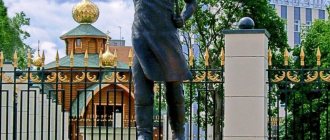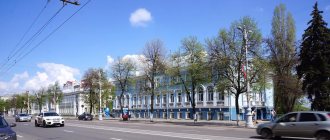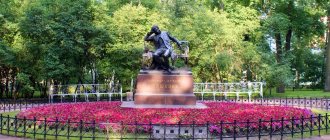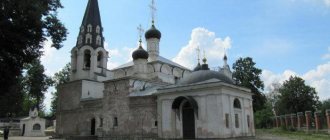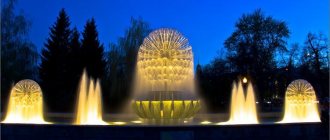The monument to Peter the Great was paid for by a merchant who was healed with mineral water
The Obelisk to Peter the Great is one of the oldest monuments in Lipetsk. It was installed back in 1839 and has the status of a regional architectural monument. It is located on Petrovsky Spusk, near the road that leads to mineral springs and facilities of the Lipetsk resort.
The obelisk to Peter the Great was erected in memory of the discovery of mineral springs by Peter I in 1700 and the establishment of iron smelting and ironworks. On the initiative of the merchant Pavel Nebuchenov, the monument was made at the Tambov Iron Foundry and opened in 1839. Nebuchenov was engaged in the wine trade in Lipetsk and was able to overcome a serious illness by being treated with mineral water. As a token of gratitude to the emperor, who discovered mineral springs in Lipetsk, the merchant built a monument to the ruler at his own expense. By that time, only two monuments to Peter had been built and all were in St. Petersburg. Therefore, for a provincial town this was a big event. By order of the governor of the province, a guard was posted at the monument.
The Obelisk of Peter I is a triangular metal pyramid on a stone base, with steps on each side. The obelisk is surrounded by a cast iron fence. Boards with bas-relief pictures are attached to the pedestal, one of which depicts the forge of Hephaestus. In the middle of the forge there is an anvil with a lightning bolt on it. The master is holding it with pincers, sharply waving a small hammer. In the corner of the forge, the heated vaulted mouth of the furnace glows with heat. An apprentice is working on his knees next to her. The image symbolizes the iron-making industry developed in Lipetsk under Peter I. And the second picture is dedicated to healing springs. Here we see the goddess Hygeia leaning on a vessel. Water pours from a vessel. The snake on the goddess’s chest is a symbol of the healing properties of Lipetsk mineral water.
Initially, there was a sign on the obelisk with the inscription to whom this monument was erected and in honor of what. After restoration in 1955, the cast-iron slab cracked and was replaced with another with the inscription “Monument to Peter I. Erected in 1839.” In 2000, a new restoration of the monument took place and the previous inscription was restored.
The shape of the obelisk - a pointed pyramid - became the subject of witticisms and jokes. The writer Gleb Uspensky, who visited the city in the second half of the 19th century, in a letter to a friend called this monument the “toothpick” of Peter I. According to one version explaining the shape of the monument, the pyramid is a sail, which indicates Lipetsk’s involvement in the creation of the Russian Navy .
How to get there?
You need to get to the “Revolution Square” or “Lower Park” stops, and then go up along the roadway. The monument is located right in the middle of Petrovsky Descent. A few meters from the monument are the Lipetsk mineral waters.
Peter I in Lipetsk
Lipetsk is one of those few cities in Russia where Peter I not only visited, but periodically lived. In memory of this, a monument was erected here in honor of the last Tsar of All Rus' and the first Emperor of All Russia, who is also considered the founder of the city, which arose on the site of Sokolsk - one of the fortresses of the Belgorod abatis, located in the Sokol area on the site of modern Demyan Bedny Street.
View of the modern city of Lipets and the Sokolsk fortress on the map of the location of shipyards on the Voronezh River in the 17th – 18th centuries
In the era of Peter the Great, the fortress city of Sokolsk became famous for its shipyard, where more than 400 plows were built, which took part in the victorious Second Azov Campaign.
Shipyard in Sokolsk
And after the Boyar Duma in 1696 decided to build regular naval ships at the Voronezh shipyards, a lot of work to provide them with equipment, anchors and other metal parts was done at the Borinsky ironworks, located in Yeletsk district.
Borinsky ironworks
However, the sharp growth of shipbuilding in the 1700s required the creation of new metallurgical enterprises, the construction of which began on the territory of the modern Lipetsk region, rich in iron ore deposits. In 1703, the Verkhny Lipsky Ironworks, named after the Lipovka River, which flows through modern Lipetsk, was born as a city from the Lipskiye Zavody settlement, and its age is counted from the date of the launch of the Verkhniy Lipetsk Iron Works. factory - 1703.
Monument to Emperor Peter the Great - founder of the city of Lipetsk (1996)
The Lipa factories continued to work intensively even after Peter I transferred the main activity of creating a regular military fleet from the Voronezh shipyards to the Baltic. Moreover, metallurgical production expanded. In 1705, the Kuzminsky Hammer Anchor Plant began working, converting cast iron from the Verkhne-Lipsky plant into high-quality steel. In 1707, the Nizhne-Lipsky plant was launched, where hammering, drilling and weapons workshops were located here. Thus, the total capacity of the Lipsky plant in the first quarter of the 18th century was 76 thousand pounds of cast iron per year, which made it possible to produce up to 500 guns annually.
Casting cannons at an ironworks
The Lipetsk factories, which predetermined the development of the city of Lipetsk from a village and settlement into an industrial center, are now reminded of by a memorial sign installed on Petrovsky Spusk from the Nizhny Park - on the site where the factory office building was located in the past.
Memorial sign on the site of the factory office of the Nizhne-Lipsky plant
And in the Nizhny Park itself, laid out on the territory of the former Lipetsk factories, on a granite pedestal lie three naval cannons from the time of Peter I. This monument-symbol is dedicated to the beginning of metallurgical production in Lipetsk, the modern image of which is inseparable from the Novolipetsk Metallurgical Plant, which is the largest Russian steelmaking enterprise and ranking 17th in the world in terms of production volumes.
Two symbols of Lipetsk: cannons of the Peter the Great era and the Novolipetsk Metallurgical Plant
Just like the ironworks, Lipetsk owes its prosperity to the famous Lipetsk mineral waters, which, according to legend, were discovered by Peter I on the territory of the Lipetsk ironworks that he founded. Aware of the healing properties of mineral waters, the Russian Tsar ordered to study the composition of spring water and install a well on the site of the source, which was later transformed into the Lipetsk pump room.
Peter I - the discoverer of Lipetsk mineral waters
As a sign of appreciation and gratitude to Emperor Peter the Great, who discovered mineral springs in the city and established iron smelting and ironworks, in 1839 the first monumental monument was inaugurated in Lipetsk on Petrovsky Spusk, which was built on the initiative and with the money of the merchant of the first guild, Pavel Nebuchenov. A native Petersburger, he held a wine trade monopoly in Lipetsk, and therefore lived here for a long time and was treated with mineral waters for a serious illness, eventually overcoming the illness.
The first monument in honor of Emperor Peter the Great, the founder of the city of Lipetsk (1839)
And in the summer of 2022, the third monument to Peter I appeared in the Lower Park - a sculpture of the emperor, installed in the center of the new Lipetsk pump room, which was built on the site of the previous pavilion, destroyed in 1924.
Sculpture of Peter I in the new Lipetsk pump room (2020)
However, the most famous monument to Emperor Peter the Great in Lipetsk is undoubtedly the casting of his palm, imprinted on an 18th-century cast-iron slab - a famous relic kept in the Lipetsk Regional Museum of Local Lore. According to one of the legends, the Russian Tsar, while visiting the foundry of the Lipa Plants, accidentally leaned his left hand on the molding mixture prepared for work and thereby made an imprint of his hand on it, that is, a foundry mold, the model of which was his hand. Of course, the foundry workers did not miss this opportunity: they filled the mold with liquid metal, and they received a cast of the king’s left palm.
A relic of the city of Lipetsk is an 18th-century cast-iron slab with a cast of the ax and palm of Peter I
Subsequently, already in the 19th century, copies of this legendary casting began to be produced in mass quantities at the Lipetsk plant of the Milovanov brothers. Several of these castings are kept in the State Historical Museum in Moscow. Copies are also presented in the exhibitions of a number of Russian museums, including the Museum of the History of St. Petersburg, "Peter's House" in St. Petersburg and Kolomenskoye, in the local history museums of Astrakhan and Tula, as well as abroad - in the National Museum of the History of Ukraine and in "Peter's House" in Holland.
Copies of the original casting of the palm of Peter I in the exhibitions of the museums of Vyborg and the Ryazan Kremlin
At the same time, the exhibition of the Lipetsk Regional Museum of Local Lore presents the first of all castings, on the reverse side of which the following is stated: “A photograph from the handprint of Peter the Great made by Him on the sand in the iron foundry founded by Him in 1707 in the city of Lipetsk!” The original is kept in the Lipetsk mineral building. water Ian. at the factory Br. Milovanovs to Lipetsk.”
Two sides of the legendary casting made by the Lipa foundries in 1707
In 2016, Lipetsk cultural figures and historians, as part of the All-Russian action “Where the Motherland Begins,” unanimously chose this historical relic as a symbol of the Lipetsk region.
Dedicated to Peter I, exhibition of the Lipetsk Regional Museum of Local Lore



